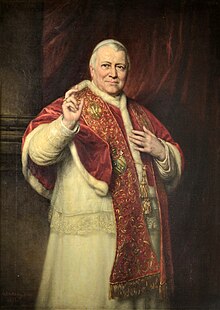Casa Santa Maria
The buildings that currently make up the Pontifical North American College's Casa Santa Maria encompass a large area, trapezoidal in shape, giving on to the Via dell'Umiltà, the Via dell'Archetto, the Vicolo del Monticello, and the Piazza della Pilotta.
[2] American College historian Robert McNamara describes the complex in 1859 as "a large building, rangy and haphazard in form, making no claim to distinction in style, but combining under one roof quarters easily adaptable to housing a hundred or more young seminarians.
Along the base of its walls lie fragments of columns, broken inscriptions, friezes, and excavated forms, which excite the curiosity of the archaeologist, and may contain interesting information for him.
[6] In the Middle Ages, before the construction of the church and convent that would eventually come to house the American College's seat in Rome, the area was covered with a complex of large Roman ruins popularly called the "Prison of Virgil."
[7] Excavation works in 1947 revealed Roman ruins under the College chapel, but they cannot be authoritatively identified as belonging to the Serapeum; instead, they may be part of the Campus Agrippae or the Statio I Cohortium Vigilum.
She returned to her native Rome from Florence, where she had worked as a governess of the princesses Eleanora and Maria de' Medici,[11] and founded a monastery in which to live out the rest of her years.
For that purpose, she purchased a block of buildings from Vincenzo Menichelli, "Cavaliere Romano," for the sum of 6,500 scudi, and named it the Monastero dell'Umiltà (Monastery of Humility).
Although untouched during the invasion of Rome in 1798 and the temporary establishment of the Roman Republic, the eventual annexation of the Papal States to the French Empire led to the suppression of all convents and monasteries in the city on May 3, 1810.
[16] The house was taken over by the French government and the nuns evicted; while they sought refuge in other monasteries or left religious life, the convent was turned into a barracks for policemen.
[18] They made some immediate changes to the monastery chapel, including installing an image of Our Lady of Guadalupe by Miguel Cabrera which had been gifted to them by Pope Benedict XIV in the mid 1700s.
[28] With the construction of a new and larger campus at Villa Gabrielli on the Janiculum, the buildings on Via dell'Umiltà were rechristened the "Casa Santa Maria," and set aside for the use of priests pursuing graduate studies at universities in Rome.
[30][31] Another example relates to the fact that the declaration as Venerable (an early step in the process of canonization) of the Visitandine nun, later saint, Margaret Mary Alacoque, occurred in the Church of the Umiltà in 1846.
When the chapel was transferred to the newly-formed American College, Archbishop Gaetano Bedini substituted it with a copy of the image of Our Lady of Mercy that is venerated in Rimini.
When the monastery was handed over to the Americans by Pope Pius IX, the architect Andrea Busiri built a storey above the church, which altered the facade by substituting a Neoclassical pediment in place of Fontana's Baroque one.
[28] Notable improvements to the chapel included a new marble floor executed in the color rosso di Francia, cleaning of the frescoes in the vault, and retouching of the stucco figures around the sanctuary.
[42] The current superior of Casa Santa Maria is the Very Reverend James J. Conn, SJ JD, JCD of the Maryland Province of the Society of Jesus.
The Visitors' Office at the Casa Santa Maria is an initiative sponsored jointly by both the North American College and the United States Conference of Catholic Bishops, and staffed by the Religious Sisters of Mercy of Alma, Michigan.

